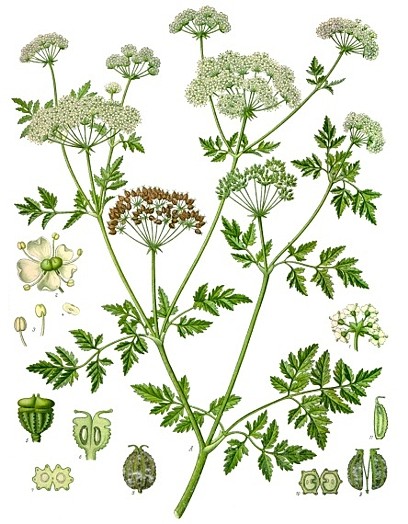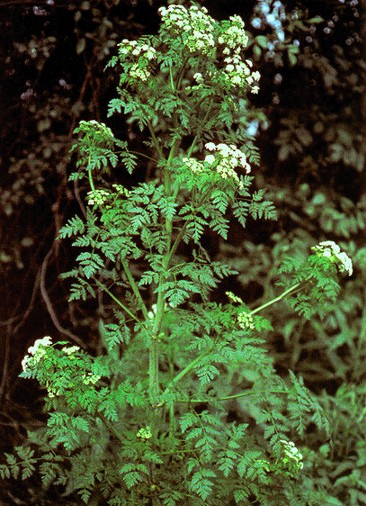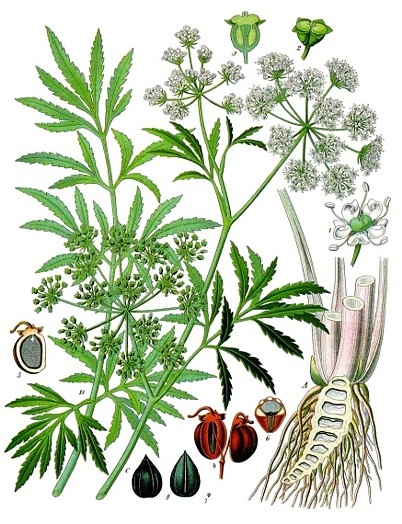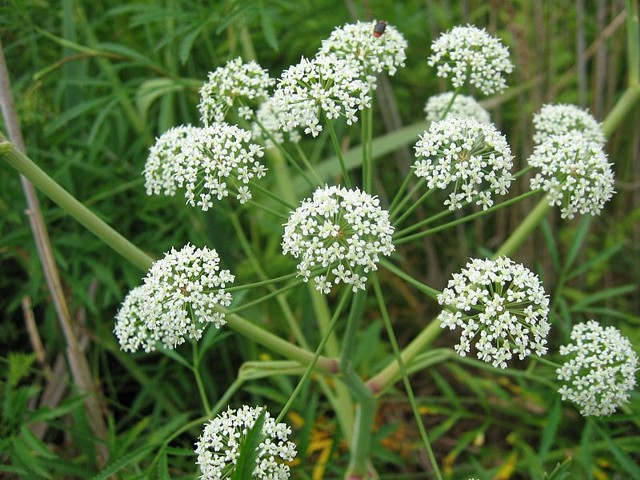Lessico
Cicuta maggiore
Conium maculatum

Il Conium maculatum (Dioscoride![]() la cicuta
la chiama køneion derivato da kôna, resina, e køneion può essersi trasformato
nel latino conium - secondo Linneo conium deriva dal greco kónis,
polvere) è la Cicuta maggiore di Socrate (da non confondere con la Cicuta
virosa
la cicuta
la chiama køneion derivato da kôna, resina, e køneion può essersi trasformato
nel latino conium - secondo Linneo conium deriva dal greco kónis,
polvere) è la Cicuta maggiore di Socrate (da non confondere con la Cicuta
virosa![]() ), un'erbacea bienne glabra della famiglia Ombrellifere (Apiacee)
di odore sgradevole, con radice fusiforme fibrosa e carnosa e caule eretto
alto fino a 2 m, cilindrico, ramoso, spesso maculato di rosso, con foglie
inferiori grandi, lungamente picciolate, e fiori bianchi raccolti in ombrelle
composte con involucro di molte brattee lanceolato-lineari, acuminate,
marginate di bianco. I frutti sono acheni ovoidi portati da un carpoforo
bipartito. Cresce nei luoghi freschi e ombrosi e fra i ruderi in Europa, Asia
e Africa settentrionale. Se ne ottiene una droga, la cicuta (termine latino di
etimologia sconosciuta), contenente quantità variabili (0,03-2%)
dell'alcaloide più importante, la coniina, la cui tossicità era nota fin
dall'antichità. L'intossicazione determina la paralisi progressiva dei
muscoli volontari, che, a partire dagli arti inferiori, si estende a tutto il
corpo lasciando integra la coscienza sino alla fase terminale. La morte
avviene per asfissia in seguito alla paralisi dei muscoli respiratori.
), un'erbacea bienne glabra della famiglia Ombrellifere (Apiacee)
di odore sgradevole, con radice fusiforme fibrosa e carnosa e caule eretto
alto fino a 2 m, cilindrico, ramoso, spesso maculato di rosso, con foglie
inferiori grandi, lungamente picciolate, e fiori bianchi raccolti in ombrelle
composte con involucro di molte brattee lanceolato-lineari, acuminate,
marginate di bianco. I frutti sono acheni ovoidi portati da un carpoforo
bipartito. Cresce nei luoghi freschi e ombrosi e fra i ruderi in Europa, Asia
e Africa settentrionale. Se ne ottiene una droga, la cicuta (termine latino di
etimologia sconosciuta), contenente quantità variabili (0,03-2%)
dell'alcaloide più importante, la coniina, la cui tossicità era nota fin
dall'antichità. L'intossicazione determina la paralisi progressiva dei
muscoli volontari, che, a partire dagli arti inferiori, si estende a tutto il
corpo lasciando integra la coscienza sino alla fase terminale. La morte
avviene per asfissia in seguito alla paralisi dei muscoli respiratori.
La cicuta è passata alla storia quale leggendaria bevanda che il filosofo
Socrate![]() fu condannato a bere per darsi la morte. Tuttavia, con tutta
probabilità (dati i sintomi descritti nel Fedone
di Platone
fu condannato a bere per darsi la morte. Tuttavia, con tutta
probabilità (dati i sintomi descritti nel Fedone
di Platone![]() ), Socrate utilizzò una mistura di veleni (cicuta da Conium
maculatum, oppio e Datura stramonium, nota volgarmente come Mela
delle spine o Noce velenosa).
), Socrate utilizzò una mistura di veleni (cicuta da Conium
maculatum, oppio e Datura stramonium, nota volgarmente come Mela
delle spine o Noce velenosa).
Le proprietà tossiche e medicamentose della cicuta sono conosciute fin dai
tempi più antichi. Era impiegata come narcotica, antispasmodica,
antitetanica, contro i dolori cancerosi, come antirabbico. Gli Ippocratici la
usavano sia per via esterna che per via interna. I Greci preparavano con i
frutti immaturi il veleno da somministrare ai condannati a morte come nel caso
di Socrate. Durante il Medio Evo si indicavano con lo stesso nome e si
confondevano la Cicuta maggiore (Conium maculatum) e la Cicuta
virosa (Cicuta acquatica). I grandi botanici del secolo XVI come Mattioli![]() , Bock
, Bock![]() , Charles de l'Écluse
, Charles de l'Écluse![]() , Caspar & Jean Bauhin distinguevano bene le
due specie e attribuivano il nome di Cicuta al Conium maculatum.
Mattioli ha fatto interessanti osservazioni su avvelenamenti dovuti a questa
specie, visti e curati personalmente da lui
, Caspar & Jean Bauhin distinguevano bene le
due specie e attribuivano il nome di Cicuta al Conium maculatum.
Mattioli ha fatto interessanti osservazioni su avvelenamenti dovuti a questa
specie, visti e curati personalmente da lui![]() .
.
Tutta la pianta è fortemente tossica. In medicina si usano le foglie e i frutti. Contiene 5 alcaloidi: la coniina, la conidrina, la pseudoconidrina, la metilconicina e la coniceina. La coniina è l'alcaloide più attivo, svolge un'azione curarica paralizzando le terminazioni dei nervi motori e successivamente i centri midollari. L'azione esercitata dagli altri 4 alcaloidi non è ancora ben conosciuta.
Le proprietà calmanti della cicuta erano considerate utili in moltissime malattie. È stata consigliata nelle nevralgie, tetano. epilessia, tosse canina, corea, asma, tossi convulsive. spermatorrea, ninfomania (aumento patologico degli impulsi sessuali nella donna, detta anche andromania) e per calmare i dolori del cancro. Per via esterna, sotto forma di cataplasmi, di empiastri o pomate; era prescritta contro i tumori al seno, le ulcerazioni fungose, le adeniti cervicali, l'impetigo, l'erisipela, le ulceri sifilitiche, ecc.
È una droga da usare con la massima cautela per la sua tossicità. La tintura si consigliava alla dose di 10-40 gocce e l'estratto alcolico alla dose di 0,05-0,30 g. Per via esterna si applicano cataplasmi di foglie fresche contuse o la pomata preparata con 5 g di estratto e 60 g di sugna (il grasso di minor pregio del maiale).
Conium
Hemlock or Poison Hemlock

Conium is a genus of two species of highly poisonous perennial herbaceous flowering plants in the family Apiaceae, native to Europe and the Mediterranean region (Conium maculatum), and to southern Africa (Conium chaerophylloides). By far the most familiar species is Conium maculatum (Hemlock or Poison Hemlock). It is a herbaceous biennial plant which grows between 1.5–2.5 metres (5–8 ft) tall, with a smooth green stem, usually spotted or streaked with red or purple on the lower half of the stem. The leaves are finely divided and lacy, overall triangular in shape, up to 50 centimetres (20 in) long and 40 centimetres (16 in) broad. The flowers are small, white, clustered in umbels up to 10–15 centimetres (4–6 in) across. When crushed, the leaves and root emit a rank, unpleasant odour sometimes compared to that of parsnips or mice.
Hemlock is known by several common names. As well as the American "Poison hemlock" and the Irish "Devil's porridge", there are also Beaver Poison, Herb Bennet (not to be confused with the geranium of that name), Musquash Root, Poison Parsley, Spotted Corobane and Spotted Hemlock. The seeds are sometimes called Kecksies or Kex. Conium maculatum is native in temperate regions of Europe, West Asia, as well as North Africa. It has been introduced and naturalised in many other areas, including Asia, North America, Australia, and New Zealand. It is often found on poorly drained soils, particularly near streams, ditches, and other surface water. It also appears on roadsides, edges of cultivated fields, and waste areas. It is considered an invasive in twelve US states. Conium grows in damp areas. It is used as a food plant by the larvae of some Lepidoptera species including Silver-ground Carpet. Poison hemlock flourishes in the spring, when most other forage is gone. All plant parts are poisonous but once the plant is dried, the poison is greatly reduced, although not gone completely.
Conium contains the piperidine alkaloids coniine, N-methylconiine, conhydrine, pseudoconhydrine and γ-coniceine (or g-coniceïne), which is the precursor of the other hemlock alkaloids.The most important and toxic of these is coniine, which has a chemical structure similar to nicotine. Coniine is a neurotoxin, which disrupts the workings of the central nervous system and is toxic to humans and all classes of livestock. Ingestion in any quantity can result in respiratory collapse and death. Coniine causes death by blocking the neuromuscular junction in a manner similar to curare; this results in an ascending muscular paralysis with eventual paralysis of the respiratory muscles which results in death due to lack of oxygen to the heart and brain. Death can easily be prevented by artificial ventilation until the effects have worn off 48–72 hours later. For an adult the ingestion of more than 100 mg of coniine (approximately 6 to 8 fresh leaves, or a smaller dose of the seeds or root) may result in fatality.
Of the total alkaloids of hemlock isolated by the method of Chemnitius and fractionally distilled, the portion boiling up to 190 °C contains most of the coniine, γ-coniceine and N-methylconiine, the conhydrine and ψ-conhydrine remaining in the higher boiling residues. For the separation of coniine from coniceine, Wolffenstein recommends conversion into hydrochlorides. These are dried and extracted with acetone, which dissolves coniceine hydrochloride, leaving the coniine salt, from which the base may then be regenerated. For final purification the coniine is converted into the D-hydrogen tartrate. It is sometimes necessary to start crystallisation by adding a crystal of the desired salt. von Braun distills the crude mixed alkaloids until the temperature rises to 190 °C, benzoylates the distillate, extracts the tertiary bases by shaking an ethereal solution with dilute acid, pours the concentrated ethereal solution into light petroleum to precipitate most of the benzoyl-δ-aminobutyl propyl ketone formed by the action of benzoyl chloride on coniceine, distills the solvent from the filtrate and collects from the residue the fraction boiling at 200-210 °C/16 mmHg, which is nearly pure benzoylconiine (bp. 203-4 °C/16 mmHg). From this a mixture of D- and L-coniines is obtained by hydrolysis, the former predominating.
In ancient Greece, hemlock was used to poison condemned prisoners. The most
famous victim of hemlock poisoning is the philosopher Socrates. After being
condemned to death for impiety in 399 BC, Socrates was given a potent infusion
of the hemlock plant. Plato described Socrates' death in the Phaedo:
"The man … laid his hands on him and after a while examined his feet
and legs, then pinched his foot hard and asked if he felt it. He said ‘No’;
then after that, his thighs; and passing upwards in this way he showed us that
he was growing cold and rigid. And then again he touched him and said that
when it reached his heart, he would be gone. The chill had now reached the
region about the groin, and uncovering his face, which had been covered, he
said — and these were his last words — 'Crito, we owe a cock to Asclepius.
Pay it and do not neglect it.' 'That,' said Crito, 'shall be done; but see if
you have anything else to say.' To this question he made no reply, but after a
little while he moved; the attendant uncovered him; his eyes were fixed. And
Crito when he saw it, closed his mouth and eyes."
Although many have questioned whether this is a factual account, careful
attention to Plato's words, modern and ancient medicine, and other ancient
Greek sources point to the above account being consistent with Conium
poisoning.
Conium maculatum is poisonous to animals. In a short time the alkaloids produce a potentially fatal neuromuscular blockage when the respiratory muscles are affected. Acute toxicity, if not lethal, may resolve in the spontaneous recovery of the affected animals provided further exposure is avoided. It has been observed that poisoned animals tend to return to feed on this plant. Chronic toxicity affects only pregnant animals. When they are poisoned by Conium maculatum during the foetuses organ formation period, the offspring is born with malformations, mainly palatoschisis and multiple congenital contractures (MCC; frequently described as arthrogryposis). Chronic toxicity is irreversible and although MCC can be surgically corrected in some cases, most of the malformed animals are lost. Since no specific antidote is available, prevention is the only way to deal with the production losses caused by the plant. Control with herbicides and grazing with less susceptible animals (such as sheep) have been suggested. Conium maculatum alkaloids can enter the human food chain via milk and fowl. Such losses may be underestimated, at least in some regions, because of the difficulty in associating malformations with the much earlier maternal poisoning.
Poison hemlock has been used as a sedative and for its antispasmodic properties. It was also used by Greek and Persian physicians for a variety of problems, such as arthritis. It wasn't always effective, however, as the difference between a therapeutic and a toxic amount is very slight. Overdoses can produce paralysis and loss of speech being followed by depression of the respiratory function and then death. It was once thought that Poison hemlock could prevent the spread of disease. This was quickly dismissed during the Bronze Age.
Cicuta virosa
Cicuta minore o acquatica

Un'altra ombrellifera velenosa, che i medici del Medio Evo confondevano con la Cicuta maggiore, è la Cicuta virosa L. chiamata volgarmente Cicuta acquatica o Cicuta minore, pianta acquatica con fusto cilindrico cavo, non pruinoso come quello della Cicuta maggiore, alto 0,50-1,50 m. Le parti aeree hanno odore e sapore simile a quello del sedano e del prezzemolo. Le foglie sono grandi con un lungo picciolo tubolare divise in foglioline lanceolate, dentate, mucronate. Il rizoma grosso, fusiforme, è cavo e diviso in vane concamerazioni; geme al taglio un latice giallastro, acre, e contiene una sostanza altamente tossica (cicutossina). Il suo avvelenamento differisce da quello della Cicuta maggiore perché comincia con crisi epilettoidi e tetaniche. È una pianta piuttosto rara. Cresce nei luoghi acquitrinosi, nelle risaie della Lomellina, nel lago di Alserio (Como), nel Mantovano ecc.

Cicuta virosa (Cowbane or Northern Water Hemlock) is a species of Cicuta, native to northern and central Europe, northern Asia and northwestern North America. It is a perennial herbaceous plant which grows up to 1–2 m tall. The stems are smooth, branching, swollen at the base, purple-striped, and hollow except for partitions at the junction of the leaves and stem. In cross section the stems have one flat side and the other sides are rounded. The leaves are alternate, tripinnate, only coarsely toothed, unlike the ferny, lacy leaves found in many other members of the family Apiaceae. The flowers are small, white and clustered in umbrella shaped inflorescences typical of the family. The many flowered umbellets have unequal pedicels that range from 5 to 11 cm long during fruiting. An oily, yellow liquid oozes from cuts to the stems and roots. This liquid has a rank smell resembling that of parsnips or carrots. The plant may be mistaken for parsnip due to its clusters of white tuberous roots. It grows in wet meadows, along streambanks and other wet and marshy areas.
There has been some dispute whether it was a hemlock of the genus Cicuta or the genus Conium which was used in ancient Greece as state poison. This poison was administered as a method of capital punishment and certainly the Greek philosopher Socrates drank a cup of some kind of hemlock infusion at his execution in 399 BC. Cicuta virosa is however primarily a northern European species, rare or absent from the Mediterranean region, making its use in Greece unlikely. The typical dose, however, was not always immediately fatal. Sometimes it was necessary to administer a second cup of the poison.
Considering the toxicity of Water Hemlock, this may be a case of misidentification. In the past this plant has had a number of colorful names including Beaver-poison, Children's-bane, Snakeweed and Musquash-poison. The plant contains cicutoxin, which disrupts the workings of the central nervous system. In humans, cicutoxin rapidly produces symptoms of nausea, emesis and abdominal pain, typically within 60 minutes of ingestion. Poisoning can lead to tremors and seizures. A single bite of the root (which has the highest concentration of cicutoxin) can be sufficient to cause death. In animals the toxic dose and the lethal dose are nearly the same. One gram of water hemlock per kilogram of weight will kill a sheep and 230 grams is sufficient to kill a horse. Due to the rapid onset of symptoms, treatment is usually unsuccessful.